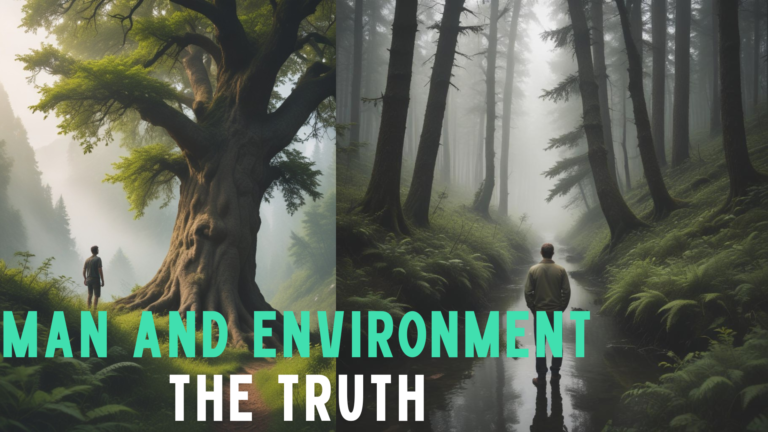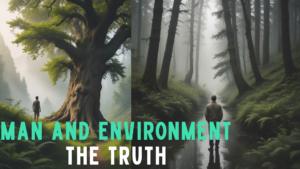
Man and Environment: A brief Introduction
Man and Environment: The relationship between them has been a topic of discussion for several centuries. Our environment is made of several natural and man made elements, each influencing and being influenced by human actions. This relation needs to get understandable for developing sustainable practices and ensuring the health and well being of the planet along with nature.
Historical Perspective
Early Human Interactions with the Environment
From the first light of the day, early humans lived in close harmony with their natural surroundings. They were dependent on the nature for food, shelter, and resources. The mutual relationship, with humans taking only what they needed to fulfil their needs and desires and nature replenishing itself. However, as population is growing so rapidly, so did the demand for resources for their survival.
Agricultural Revolution and its Impact
The agricultural revolution brought about a significant change in interaction between the man and environment during the past few decades. The development in the field of farming allowed humans to settle in one place for farming and agricultural practices, leading to the establishment of large number of communities and eventually large number of cities. This change has led to extreme deforestation as the land needed for agricultural practices and farming has to be taken by clearing the forest areas and the alteration of natural landscapes to make way for farmland to fulfill human needs for their survival.
Industrial Revolution and Environmental Changes
The Industrial Revolution brought about an unexampled technological advancements and economic growth for human growth and survival. However, it also led to significant and aggressive environmental degradation. Factories emitted pollutants into the air, water and land, and the due to high demand for several of tons of raw materials by factories for the production of goods led to aggressive deforestation and mining which highlights the ever-evolving relationship between man and environment..
Current Environmental Issues
Climate Change
As per the conditions nowadays, i.e. temperature is going above 50°C, the trees are getting dried, severe heat waves are being declared by the government, in the future if this continues then the temperature may rise over 60°C too and there is the major chances of more deaths due to severe heat birds are getting fainted and die due to aggressive heat.
Therefore, Climate change issue is perhaps the most alarming environmental issue of our time and if not addressed now it will create a disastrous situation in the coming future for both man and environment. The increase in greenhouse gases, primarily from burning fossil fuels, cutting down of trees has led to global warming. This has resulted in melting polar ice glacier, rising in sea levels, and extreme weather events like extreme heat.
Pollution
Pollution affects air, water, and soil quality. Industrial activities, vehicular emissions, and improper waste disposal are major contributors. Air pollution, in particular, has serious health implications, including respiratory diseases and cardiovascular problems.
Deforestation
Deforestation, driven by logging, agriculture, and urban expansion, leads to habitat loss and contributes to climate change. Forests act as carbon sinks, absorbing CO2 from the atmosphere. Their destruction exacerbates global warming and threatens biodiversity.
Loss of Biodiversity
Human activities have led to the extinction of numerous species and the endangerment of many others. Habitat destruction, pollution, and climate change disrupt ecosystems and reduce biodiversity, which is essential for ecosystem resilience and human survival.
Human Impact on the Environment
Urbanization
Urbanization transforms natural landscapes into built environments which leads to habitat destruction and increased pollution. Urban areas are major consumers of energy and resources and they are consuming resources aggressively, contributing to environmental degradation at a peak rate.
Industrialization
Industrialization, while driving economic growth, often comes at the expense of the environment and natural resources. Factories release heavily toxic pollutants, and industrial processes consume vast amounts of natural resources, leading to depletion of resources and environmental harm at the higher rate.
Resource Exploitation
Overexploitation of natural resources, such as minerals, fossil fuels, and water, leads to resource depletion and environmental degradation. Sustainable management of these resources is crucial to prevent long-term damage.
Education and Awareness
Role of Education in Promoting Environmental Awareness
Education plays a crucial role in raising awareness among humans to get to know about the rising environmental issues and promoting sustainable practices for eco-friendly environment and a healthy living for both man and environment. By integrating environmental education into curriculum, schools can equip students with the knowledge and skills needed to address these challenges and to get some real life knowledge and experience which students do not get from the so called knowledge from their History, English, and many other books due to this British Education System which is still followed in India after several years of independence.
Environmental Education Programs
Several Features and Programs that focus on environmental education, such as eco-clubs, campaigns for eco-friendly environment, outdoor learning experiences, and environmental science courses, creates a deeper understanding and appreciation of the environment among students which create a self responsibilities in them to preserve the environment and its resources.
Impact of Education on Sustainable Practices
Informing individuals about the knowledge of sustainable environment are more likely to adopt sustainable practices, such as recycling, conserving water, and reducing energy consumption. Education has the power to make people understand so they can make environmental-friendly responsible decisions in their daily lives and to create a mutual bond between man and environment.
Sustainable Practices
Renewable Energy Sources
Transition from the current sources of energy to renewable sources of energy i.e. solar, wind and hydroelectric power, is very much essential for reducing green house gas emissions and the current climate change issues. The renewable sources are much more efficient and have a lower environmental impact as compared to fossil fuels.
Conservation Efforts
There is need to put some conservation efforts, such as preserving natural habitats, protecting endangered species and restoring ecosystem, have now become crucial step as if actions are not taken now then it will become more difficult for the man to survive. Conservation initiatives also involves community participation and government support.
Sustainable Agriculture
Practices like organic farming, crop rotation, and agroforestry comes under sustainable agriculture practices which aim to reduce environmental impact while ensuring food security. These sustainable practices promote good soil health, conserve water, and also it reduces reliance of chemical inputs in any of the farming or agriculture.
Policy and Legislation
International Environmental Agreements
Some of the International agreements, such as the Paris Agreement and the Kyoto Protocol, are mainly aimed to address global environmental issues through collective action. These agreements sets some targets for reducing greenhouse gas emissions, reduce pollutants which is getting released from factories into land, rivers, air and also to promote sustainable development.
National Policies and Regulations
National governments play a vital role in enforcing environmental protection laws and regulations. Policies that support the use of renewable source of energy, regulate pollution by limiting the release of pollutants from factories to land, water, air, and protect natural resources that are essential for sustainable development and for future generations.
Role of Governments and NGOs
Governments and non-governmental organizations (NGOs) work together to implement environmental policies to protect the environment and its resources, raise awareness for the protection of the environment, and support conservation projects. NGOs often play a crucial role in advocating for environmental protection and engaging communities in sustainable practices.
Case Studies
Successful Environmental Conservation Projects
Some of the examples of most famous environmental conservation projects some of them are as- reforestation initiatives in Amazon, wildlife conservation in Africa demonstrate the positive impact on environmental balance and the coordinated efforts to safe the environment.
Innovative Sustainable Practices
Some of the innovative techniques can be practiced such as vertical farming, urban green spaces, and sustainable building designs how technology and creativity can address environmental challenges and also helps to promote sustainable future.
Future Directions
Technological Advancements
From the last few years technology has made high advancements in the fields of artificial intelligence and biotechnology have the potential to monitor environmental issues, resource management and sustainable practices. These technology if used in legal and proper way can help to solve the environmental issues.
Future Challenges and Opportunities
Significance progress has been made in the field of environmental protection but that is not enough for the upcoming future where there will be problems like aggressive population growth, lack of resources and most importantly climate change requires continuous improvement and commitment to save the environment. Opportunities for improvement which lie under global cooperation, policy reform, and widespread adoption of sustainable practices.
Conclusion
The ultimate relation between man and environment is very complex. From the above points i.e. historical context, current issues, and possible solutions we as humans can work towards a more sustainable future for the present as well as future generations. Proper education and awareness regarding the current issues are key to fostering an environmentally conscious society. Though collective efforts, innovative practices, and strong policies is a present need to protect our planet and to maintain it habitable for the future generations.
Our Social Media Handles:
Categories



Addressing Controversies Surrounding NEET 2024: Insights from the Ministry of Education

“How to Create Interest in Maths: Unlocking the Magic of Numbers”


